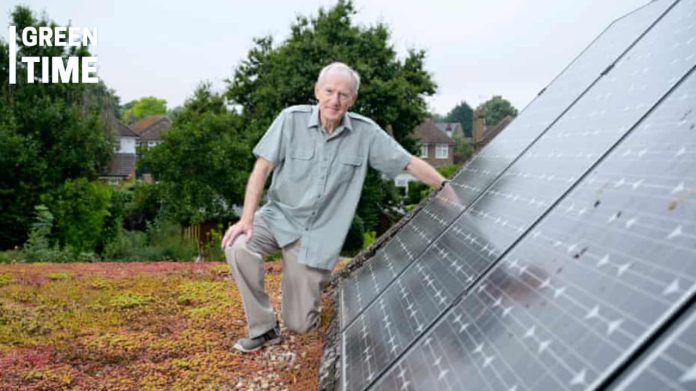In August 2010, a memorable day marked the beginning of my journey towards a sustainable home. My solar panels were connected to the grid for the first time, and the sight of the old-style electricity meter whizzing backwards captivated the builders who were supposed to be finishing the plastering and insulation.
For months, I had been refurbishing my new 1930s bungalow with several “green” improvements, mirroring the advice I had been giving Guardian readers during my 16 years as an environment correspondent. Friends remarked that I was finally “putting my money where my mouth had been.”
We started with super-thick insulation, three times the government-recommended minimum, and a green roof over the flat roof extension for extra insulation. To brighten the dim interior, we installed four triple-glazed skylights and converted a double garage into a library, reinforcing the flat roof to accommodate 10 south-facing solar panels.
The initial cost for the 2.4kW solar system was £12,000, more than double the price of a much better system available 14 years later. The incentive was the government’s generous feed-in tariff, paying householders 40p per kWh of electricity produced, index-linked and guaranteed for 20 years. This scheme ensured I received payments even if I used all the electricity myself.
Over 14 years, these solar panels have generated more than £1,000 annually from the feed-in tariff and significantly reduced my electricity bills, making the investment profitable with six years remaining on the contract.
One of the most enjoyable aspects has been a solar gadget in my kitchen that displays real-time power production, updated every 30 seconds, along with daily, monthly, and total production since installation. This device has turned me into a solar enthusiast, monitoring how even the dullest, rainiest days still generate some electricity. Optimal conditions for my panels are cooler sunny days, with a record daily total of over 15kWh in May 2020 during the lockdown, likely due to the absence of sun-blocking aircraft contrails.
Despite some setbacks, like a neighbor’s two-story extension shading half the array in winter, the panels have consistently provided significant annual electricity totals.
Since my initial installation, solar technology has advanced significantly. Modern systems now include panels that heat water and store surplus electricity in batteries, allowing for free electric car charging and nighttime usage. Unfortunately, upgrading my outdated system would disrupt the lucrative feed-in tariff, so instead, I invested in a heat pump three years ago, costing £13,000 with a £7,500 government subsidy. This upgrade rendered the gas boiler redundant and eventually led to the complete removal of the gas meter, making my home run entirely on fossil-free energy.
Now, all the electricity for my home is sourced from renewables, supplied by a company dedicated to green energy. My house stands as a testament to the benefits of embracing solar technology, providing both financial savings and a warm, comfortable, and environmentally friendly living space.
This journey has not only fulfilled my commitment to sustainability but also brought about a sense of community among friends who installed solar panels, leading to many enlightening and enthusiastic discussions about our respective systems. As we continue to advance in green technology, my experience underscores the significant impact individual actions can have on our shared goal of a sustainable future.

